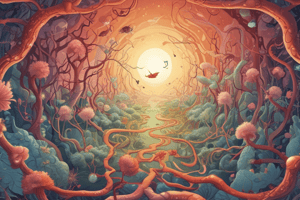Podcast
Questions and Answers
What is the scientific study of life and living organisms?
What is the scientific study of life and living organisms?
Biology
What is the branch of biology that studies the relationships between organisms and their environment?
What is the branch of biology that studies the relationships between organisms and their environment?
Ecology
What is the basic structural and functional unit of life?
What is the basic structural and functional unit of life?
Cell
What is the term for the physical and behavioral characteristics of an individual resulting from the interaction of its genotype and environment?
What is the term for the physical and behavioral characteristics of an individual resulting from the interaction of its genotype and environment?
What is the mechanism by which individuals with favorable traits are more likely to survive and reproduce, passing those traits to their offspring?
What is the mechanism by which individuals with favorable traits are more likely to survive and reproduce, passing those traits to their offspring?
What defines the trophic levels in a food web?
What defines the trophic levels in a food web?
Which of the following is an example of predation?
Which of the following is an example of predation?
How does deforestation primarily impact ecosystems?
How does deforestation primarily impact ecosystems?
What does conservation biology focus on?
What does conservation biology focus on?
What is a significant consequence of climate change on ecosystems?
What is a significant consequence of climate change on ecosystems?
Which branch of genetics deals with traits passed from parents to offspring based on Gregor Mendel's principles?
Which branch of genetics deals with traits passed from parents to offspring based on Gregor Mendel's principles?
What is the primary function of RNA in genetic processes?
What is the primary function of RNA in genetic processes?
Which term describes a community of living organisms interacting with their physical environment?
Which term describes a community of living organisms interacting with their physical environment?
Which of the following is an example of non-Mendelian inheritance?
Which of the following is an example of non-Mendelian inheritance?
What is the role of a niche in an ecosystem?
What is the role of a niche in an ecosystem?
Which of the following processes involves the duplication of DNA?
Which of the following processes involves the duplication of DNA?
What defines a biome?
What defines a biome?
Which application of genetics involves modifying the genes of an organism?
Which application of genetics involves modifying the genes of an organism?
Flashcards
Biology Definition
Biology Definition
Biology is the scientific study of life and living organisms.
Ecosystem Definition
Ecosystem Definition
An ecosystem is a community of organisms and their physical environment interacting.
Natural Selection
Natural Selection
Organisms with helpful traits are more likely to survive and reproduce, passing those traits to their offspring.
Cell Definition
Cell Definition
Signup and view all the flashcards
Gene Definition
Gene Definition
Signup and view all the flashcards
Food Web
Food Web
Signup and view all the flashcards
Trophic Levels
Trophic Levels
Signup and view all the flashcards
Competition
Competition
Signup and view all the flashcards
Predation
Predation
Signup and view all the flashcards
Symbiosis
Symbiosis
Signup and view all the flashcards
What is Botany?
What is Botany?
Signup and view all the flashcards
What is Zoology?
What is Zoology?
Signup and view all the flashcards
Microbiology
Microbiology
Signup and view all the flashcards
What is Ecology?
What is Ecology?
Signup and view all the flashcards
What is a Gene?
What is a Gene?
Signup and view all the flashcards
What is DNA?
What is DNA?
Signup and view all the flashcards
Transcription
Transcription
Signup and view all the flashcards
What is Genetic Engineering?
What is Genetic Engineering?
Signup and view all the flashcards
Study Notes
Definition and Scope
- Biology is the scientific study of life and living organisms, including their structure, function, growth, evolution, distribution, and taxonomy.
- It explores the diversity of life forms, from molecules to ecosystems.
Branches of Biology
- Botany: study of plants, including their structure, growth, evolution, classification, and interactions with the environment.
- Zoology: study of animals, including their structure, behavior, evolution, classification, and interactions with the environment.
- Microbiology: study of microorganisms, including bacteria, viruses, and other microorganisms.
- Ecology: study of the relationships between organisms and their environment.
Cell Biology
- Cell: the basic structural and functional unit of life, consisting of cell membrane, cytoplasm, and genetic material (DNA or RNA).
- Cellular organelles: specialized structures within cells, such as mitochondria, chloroplasts, and ribosomes, that perform specific functions.
- Cell division: process by which cells reproduce, including mitosis and meiosis.
Genetics
- Genes: units of heredity that carry information from one generation to the next.
- Genotype: genetic makeup of an individual, including all its genes.
- Phenotype: physical and behavioral characteristics of an individual, resulting from the interaction of its genotype and environment.
- Mendelian inheritance: principles of heredity, including segregation, independent assortment, and dominance.
Evolution
- Theory of evolution: process by which species change over time through natural selection, genetic drift, mutation, and gene flow.
- Natural selection: mechanism by which individuals with favorable traits are more likely to survive and reproduce, passing those traits to their offspring.
- Species: group of interbreeding organisms that can produce fertile offspring.
Ecosystems and Ecology
- Ecosystem: community of organisms and their physical environment, interacting through nutrient cycles, energy flow, and species interactions.
- Food chain: sequence of organisms that eat other organisms, with energy flowing from one level to the next.
- Energy pyramid: representation of energy flow through an ecosystem, with producers at the base and top predators at the apex.
Definition and Scope
- Biology is the scientific study of life and living organisms, including structure, function, growth, evolution, distribution, and taxonomy.
- Biology explores the diversity of life forms, from molecules to ecosystems.
Branches of Biology
- Botany is the study of plants, including their structure, growth, evolution, classification, and interactions with the environment.
- Zoology is the study of animals, including their structure, behavior, evolution, classification, and interactions with the environment.
- Microbiology is the study of microorganisms, including bacteria, viruses, and other microorganisms.
- Ecology is the study of the relationships between organisms and their environment.
Cell Biology
- A cell is the basic structural and functional unit of life, consisting of a cell membrane, cytoplasm, and genetic material (DNA or RNA).
- Cellular organelles are specialized structures within cells that perform specific functions, such as mitochondria, chloroplasts, and ribosomes.
- Cell division is the process by which cells reproduce, including mitosis and meiosis.
Genetics
- Genes are units of heredity that carry information from one generation to the next.
- Genotype is the genetic makeup of an individual, including all its genes.
- Phenotype is the physical and behavioral characteristics of an individual, resulting from the interaction of its genotype and environment.
- Mendelian inheritance is the principle of heredity, including segregation, independent assortment, and dominance.
Evolution
- The theory of evolution is the process by which species change over time through natural selection, genetic drift, mutation, and gene flow.
- Natural selection is the mechanism by which individuals with favorable traits are more likely to survive and reproduce, passing those traits to their offspring.
- A species is a group of interbreeding organisms that can produce fertile offspring.
Ecosystems and Ecology
- An ecosystem is a community of organisms and their physical environment, interacting through nutrient cycles, energy flow, and species interactions.
- A food chain is a sequence of organisms that eat other organisms, with energy flowing from one level to the next.
- An energy pyramid is a representation of energy flow through an ecosystem, with producers at the base and top predators at the apex.
Studying That Suits You
Use AI to generate personalized quizzes and flashcards to suit your learning preferences.




